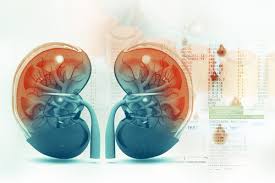Table of Contents
ToggleRENAL FAILURE
Renal failure refers to reduction in renal/kidney function.
It can be acute or chronic
ACUTE RENAL FAILURE
Acute Renal Failure is the rapid decline in the kidney’s ability to clear the blood of toxic substances e.g poison, drugs and antibodies that react against the kidneys leading to accumulation of metabolic waste products e.g. urea in blood.
A healthy adult eating a normal diet needs a minimum daily urine output of approximately 400 ml to excrete the body’s waste products through the kidneys. An amount lower than this indicates a decreased GFR.
Pathophysiology of Acute Renal Failure/Acute Kidney Failure
Although the pathogenesis of Acute Renal Failure and oliguria is not always known, many times there is a specific underlying problem.
There are underlying problems that cause the development of Acute Renal Failure such as hypovolemia, hypotension, reduced cardiac output and failure, and obstruction of the kidney.
For Example, Lets say the underlying cause is Hypovolemia; Pathophysiology would be;
Hypovolemia leads to glomerular hypoperfusion but filtration rate is preserved during mild hypoperfusion through several compensatory mechanisms e.g R.A.A.S
During states of more severe hypoperfusion these compensatory response are overwhelmed and glomerular filtrate falls leading to Pre-renal Acute Renal Failure.
- Decreased kidney function. With inadequate blood flow to the kidney, there is impaired kidney function.
- Failure. If the underlying conditions are not treated and corrected, they can lead to permanent damage of the kidneys.
Etiology of Acute Renal Failure
A. PRE-RENAL ACUTE RENAL FAILURE – These are conditions that reduce blood supply to the kidneys leading to ischemia in the kidneys.
– HYPOVOLAEMIA
- Haemorrhage, anaemia, asphyxia, burns and dehydration.
- Gastro-intestinal fluid loss- vomiting, surgical drainage, diarrhoea.
- Renal fluid loss, osmotic diuresis eg Diabetes Meletus, hypoadrenalism.
- Sequestration in high vascular areas eg Pancreatitis, trauma.
– LOW CARDIAC OUTPUT
- Diseases of the myocardium, valves and pericardium, arrythmias, and tamponade(excessive fluid in the pericardium resulting into poor dilatation of the heart muscles.
- Others include, Pulmonary Hypertension, Massive pulmonary embolus, Septic shock,
B. INTRARENAL/INTRINSIC RENAL CAUSES – Actual tissue damage to the kidneys caused by inflammatory or immunological response.
- Toxins e.g Nephrotoxic drugs e.g. aminoglycosides( streptomycin, Gentamycin etc), Rifampicin, Tetracycline.
- Diseases of the glomeruli -Glomerulonephritis – Pyelonephritis
- Acute Tubular necrosis
- Vasculitis
- Heavy metal like phenol, carbon tetrachloride, chlorates etc
- Endogenous; haemolysis (RH Incompatibility), uric acid oxalates.
C. POST RENAL CAUSES. – Conditions that cause urinary outflow obstruction.
- Such obstruction can result from tumors, stones, edema, prostatic hyperplasia.
Phases/Stages of Acute Renal Failure
There are four phases of Acute Renal Failure when Initiation phase is included, otherwise they are 3 stages that begin with Oliguria
- Initiation. The initiation period begins with the initial insult, and ends when oliguria develops.
- Oliguric Phase/ Oliguria. This stage is characterized by reduced urine output of <400mls/day. It lasts for a few days. The oliguria period is accompanied by an increase in the serum concentration of substances usually excreted by kidneys.
- Diuretic Phase/ Diuresis. Urine output increases to as much as 4000 mL/day but no waste products, at the end of this stage you may begin to see improvement. The diuresis period is marked by a gradual increase in urine output, which signals that glomerular filtration has started to recover.
- Recovery. The recovery period signals the improvement of renal function and may take 3 to 12 months. If it is insufficient, it develops to Chronic renal failure.
Clinical features of Acute Renal Failure
- There is oliguria with rapid rise in blood urea and creatinine(Onset is 1 – 3 days with raised blood urea nitrogen (BUN) and creatinine and possible decreased urine output). This occur in 7-20 days.
- Electrolyte imbalance -hyperkaliemia,
- Fluid imbalance e.g. generalized edema.
- Decreased appetite due to nausea
- Vomiting
- Lethargy
- Central nervous system symptoms which include drowsiness, headache, muscle twitching, and Seizures/convulsions
- Pallor
- Pulmonary oedema leading to dyspnea
- Dryness of the skin and mucous membrane are due to dehydration.
- Sign of congestive heart failure
• Severe hypertension
Investigations/Diagnostic Findings
Urine
- Volume: Usually less than 100 mL/24 hours (anuric phase) or 400 mL/24 hours (oliguric phase)
- Color: Dirty, brown sediment indicates the presence of RBCs, hemoglobin.
- Specific gravity: Less than 1.020 reflects kidney disease, e.g., glomerulonephritis, pyelonephritis.
- Protein: High-grade proteinuria (3–4+) strongly indicates glomerular damage when Red Blood Cells and casts are also present
- Glomerular filtration rate (GFR): The GFR is a standard means of expressing overall kidney function.
Blood
- BUN/Cr: Elevated
- Complete blood count (CBC): Hemoglobin (Hb) decreased in presence of anemia.
- Arterial blood gases (ABGs): Metabolic acidosis (pH less than 7.2) may develop because of decreased renal ability to excrete hydrogen and end products of metabolism.
- Chloride, phosphorus, and magnesium, Sodium, Potassium: Elevated related to retention and cellular shifts (acidosis) or tissue release (red cell hemolysis).
Imaging
- Retrograde pyelogram: Outlines abnormalities of renal pelvis and ureters.
- Renal arteriogram: Assesses renal circulation and identifies extravascularities, masses.
- Voiding cystoureterogram: Shows bladder size, reflux into ureters, retention.
- Renal ultrasound: Determines kidney size and presence of masses, cysts, obstruction in upper urinary tract.
- Nonnuclear computed tomography (CT) scan: Cross-sectional view of kidney and urinary tract detects presence/extent of disease.
- Magnetic resonance imaging (MRI): Provides information about soft tissue damage.
- Excretory urography (intravenous urogram or pyelogram): Radiopaque contrast concentrates in urine and facilitates visualization of KUB(Kidney, Ureter, Bladder)
Management of Acute Renal Failure
Aims
- To restore normal chemical balance
- To prevent complications until repair of renal tissue has occurred.
In Hospital.
- Admit the patient and ensure adequate rest, assist the patient in daily activities to maintain energy.
- Fluid restriction and Salt restriction (half tea spoon a day) should be considered by the nurse.
- Monitor fluid intake and output on a fluid balance chart to determine improvement and control fluid deficit or excess. To avoid over load give 600ml + previous fluid loss
- Assess for edema, skin turgor fontanelles-may also show either fluid overload or dehydration
- Monitor blood pressure and weigh the patient twice daily and monitor other vital observations.
- Dialysis is done in severe fluid overload, pulmonary edema, congestive cardiac failure, severe hypertension , hyperkaliemia, increased BUN and can either be hemodialysis or peritoneal dialysis.
- Maintain nutrition, restrict protein but give adequate calories.
- Frequently check urine and electrolytes.
- Treat complications such as hypertension, convulsions, infections accordingly.
- Sodium bi carbonate 50- 100mcg is give in case of metabolic acidosis.
- IV dextrose 50%, insulin, and calcium replacement may be administered to shift potassium back into cells; diuretic agents are often administered to control fluid volume.
- Skin integrity is maintained by proper care of pressure areas and regular turning of severely ill patients.
- Nephritic drugs should be stopped
- Treat shock with blood transfusion in haemorrhagic shock to replace blood loss.
CHRONIC RENAL FAILURE
This refers to gradual, progressive loss of renal function due to irreversible damage of the nephrons.
Symptoms occur when 75% of function is lost but considered chronic if 90 – 95% loss of function.
Etiology of Chronic Renal Failure
- Polycystic kidney disease
- Nephritic syndrome
- Diseases such as glomerulonephritis, pyelonephritis e.t.c
- Secondary causes e.g. diabetes nephropathy and hypertensive nephrosclerosis.
- Systemic diseases like sickle cell anaemia, vasculitis and HIV associated nephropathy
- Reflux nephropathy due to any cause
- Analgesic nephropathy
Clinical presentation of Chronic Renal Failure
- Cardiovascular symptoms include: Hypertension, arrythmias, pericardial effusion, peripheral, edema, chest pain, fatigue
- Neurological symptoms include: burning pain, itching and paresthesia, muscle cramping and twitching due to uremia, patchy and lethargy, drowsy, confusion, and seizures, coma and EEG changes.
- Renal symptoms include: salt overload, accumulation of potassium with muscle weakness, fluid overload and metabolic acidosis, proteinuria and glycosuria, urine contains RBC’s, WBC’s, and casts
- Gastro intestinal tract symptoms include: stomatitis, peptic ulcers due to gastritis, pancreatitis, constipation, nausea and vomiting.
- Respiratory tract symptoms include: pulmonary edema, pleural effusion, dyspnea and kussmaul’s respirations from acidosis
- Endocrine symptoms include: stunted growth in children, amenorrhea, male impotence, thyroid and parathyroid abnormalities
- Hemopoietic symptoms include: anaemia, bleeding and clotting disorders, i.e purpura and hemorrhage from body orifices , ecchymoses
8. Skeletal symptoms include: Muscle and bone pain, pathological features.
Management of Chronic Renal Failure
- Fluid and salt restriction and monitored closely.
- Restriction of protein intake because of kidney’s inability to remove wastes
- Diuretic therapy e.g. furosemide
- Antihypertensive to treat hypertension
- Erythropoietin or transfusion to treat anaemia.
- Vitamin D to prevent bone disease
- In late stages dialysis and renal transplant are done.
- Keep on monitoring GFR, serum creatinine, serum urea
- Avoid food which contain a lot of potassium like fruits
- Monitor cardiac rhythm and blood pressure every 8 hours for severely admitted patients.
- Encourage diet with high carbohydrates with prescribed limits of sodium, potassium phosphorus and proteins
- Protect confused patients from injury and avoid medication which affects the kidney
- Monitor patients weight



Good notes but pathophysiology is stillmy problem